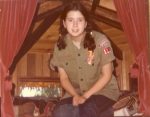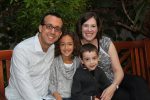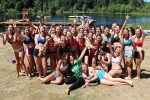Dawn Lerman, age 15 in this photo, at summer camp. (photo from Dawn Lerman via JNS.org)
In My Fat Dad: A Memoir of Food, Love and Family, with Recipes (Berkley Books, 2015), New York Times wellness blogger and nutritionist Dawn Lerman shares her food journey and that of her father, a copywriter from the Mad Men era of advertising.
Lerman spent her childhood constantly hungry. She craved good food as her father, 450 pounds at his heaviest, pursued endless fad diets, from Atkins to Pritikin to all sorts of freeze-dried, saccharin-laced concoctions, and insisted the family do the same – even though no one else was overweight. Her mother, on the other hand, could barely be bothered to eat a can of tuna over the sink; she was too busy ferrying her other daughter to acting auditions and scolding Lerman about cleaning the house.
My Fat Dad is as much a coming-of-age memoir as it is a recipe collection from Lerman’s upbringing and culinary adventures. Released as part of the 2016 JNS.org summer camps special section, below is an adapted excerpt from Chapter 17 of My Fat Dad, in addition to a recipe for fruit-infused bug juice.
My little sister April’s contract was renewed. She and my mom were going to spend the summer in Washington, D.C., where she was a principal orphan in the first national tour of the Broadway show Annie. I was going to Hillcrest Camp for a month before joining them.
Hillcrest was a performing arts camp in Connecticut where teenagers were allowed the freedom to arrange their own schedules. The activities ranged from glassblowing, to silk-screening, to acting, to stained glass-making, to, most important, free choice, which translated into hanging out with cute, artsy boys.
Marley was my best friend from middle school. We spoke daily, even though we’d both transferred schools after the sixth grade. She taught me how to line my eyes on the inside ring and the art of applying black nail polish to look edgy. Marley had already been to the sleep-away camp the past three summers and was instrumental in convincing my mom to allow me to go. She said the experience was life-changing, and she really found her voice as an artist in the printmaking shop. My mom thought I was getting too serious with my boyfriend, Hank, after I told him during the ninth grade prom that I loved him, so she signed me up immediately – even though she found the cost to be outrageous.
My mom equated every experience, every meal and every activity with cost. She talked about money incessantly, not in the normal way like other parents did. “We need to save up, we can’t afford it, let’s wait till it goes on sale, maybe next year,” she would say. It seemed to have nothing to do with if we could afford it, but everything to do with the fact she thought she was always being ripped off, unless it was a super-sale. Any normal purchase – food, clothes, toiletries – seemed to bring her physical pain and enraged her, causing her to lash out. I was usually on the receiving end of these outbursts, swallowing her rage and internalizing the message that I was not worthy of normal comforts.
I never really did anything wrong, but somehow I could never do anything right, and my mother constantly used words and tones that were so harsh that I was in a constant state of turmoil. The fact that I preferred fresh seafood and vegetables to soggy SpaghettiO’s for dinner somehow irked her, making her feel unappreciated and angered. I was not your typical kid, and my parents – my 450-pound dad and my flamboyant stage mom – were not your typical parents. The combination of our unique quirks and habits was often toxic and unsettling. So the thought of going to overnight camp – where I wouldn’t need to worry what diet my dad was on or if I would have enough money for food, as most nights I was left on my own – was a welcome relief.
Read more – and find the recipe for “bug juice” – at jns.org.



 Enter her book, Be Yourself, with illustrations by Jacob and Swirsky’s sister-in-law Jaimee Appel. It can be purchased at beyourselfbook.ca.
Enter her book, Be Yourself, with illustrations by Jacob and Swirsky’s sister-in-law Jaimee Appel. It can be purchased at beyourselfbook.ca.


